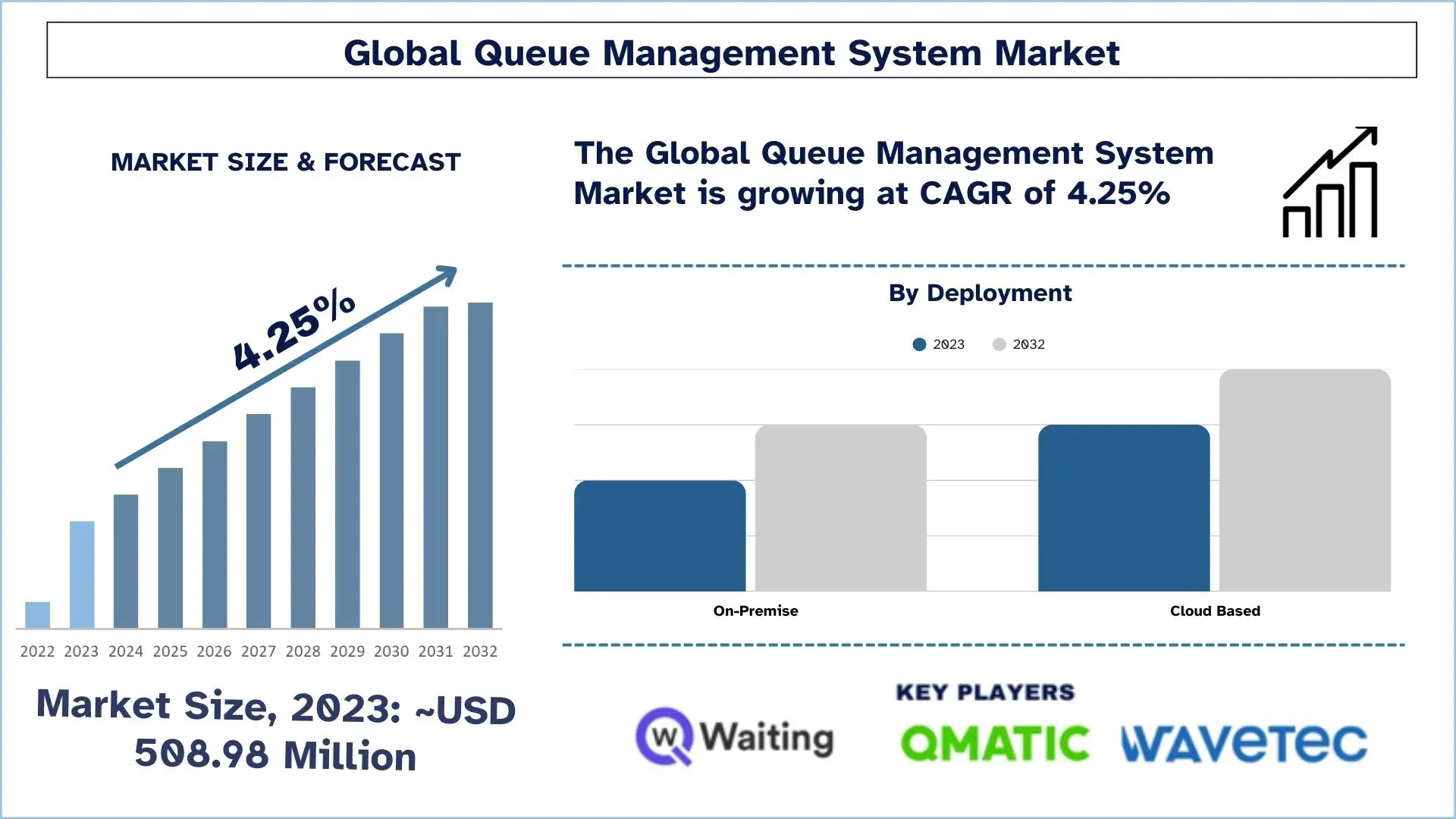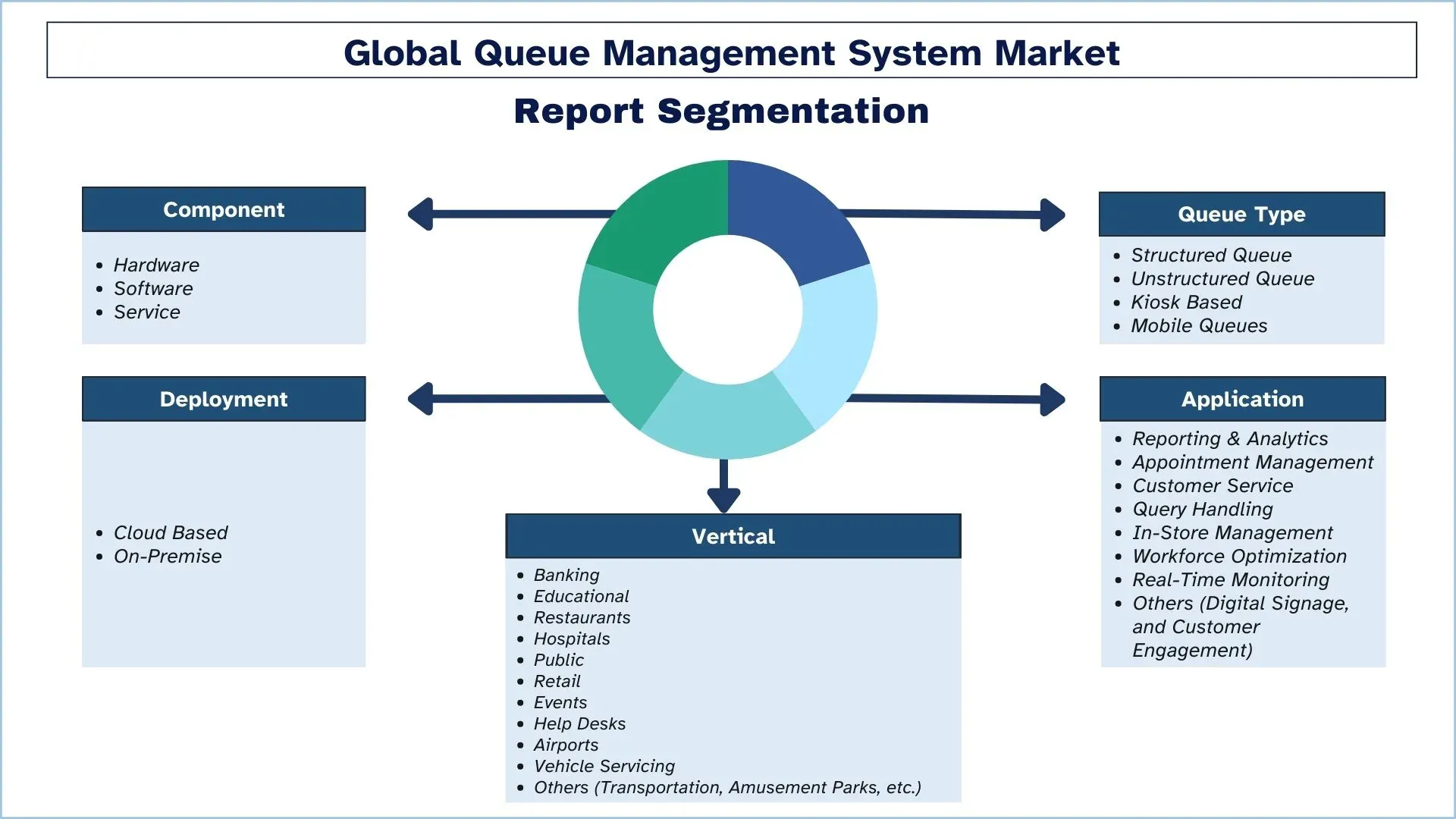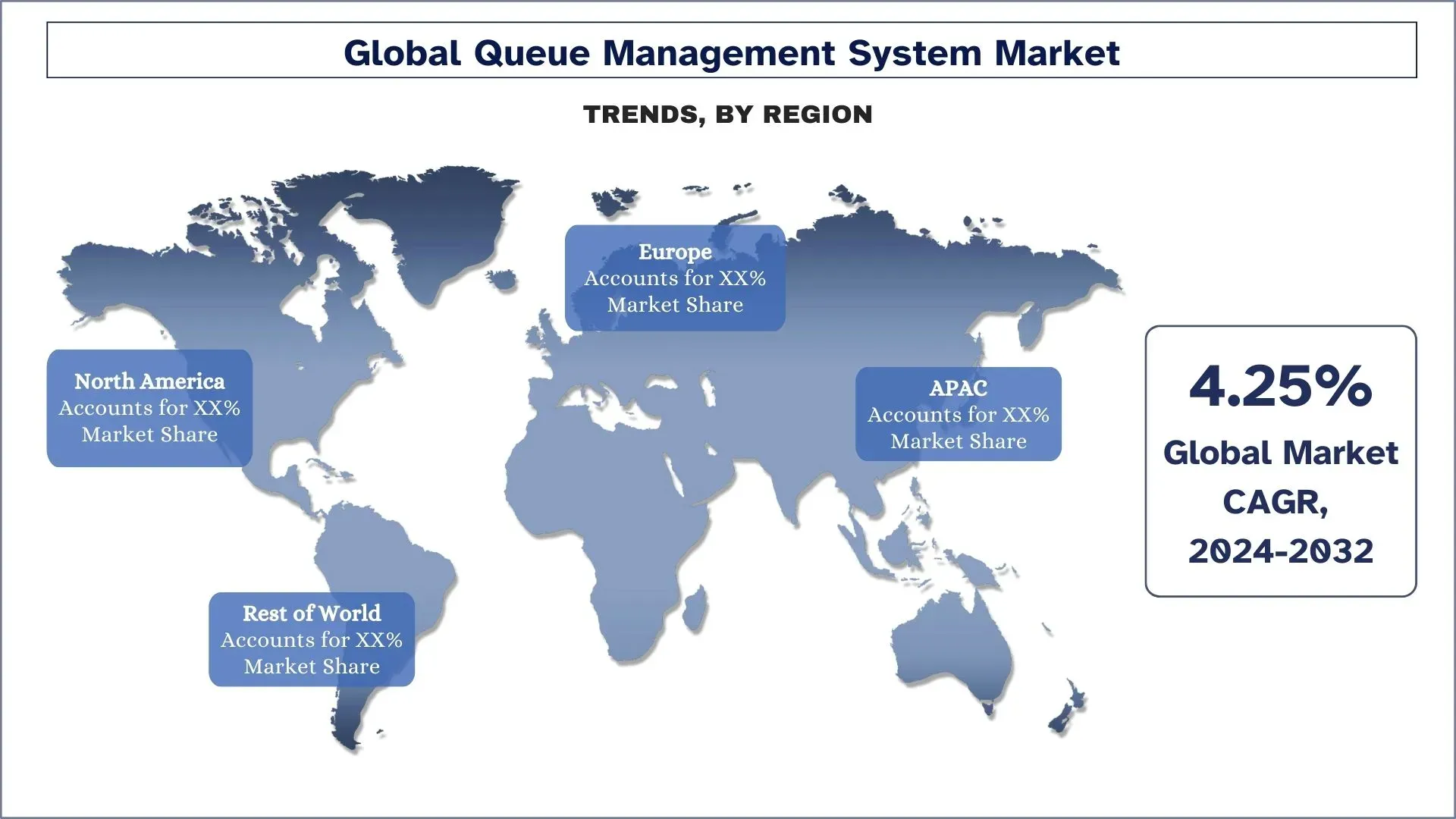- Home
- About Us
- Industry
- Services
- Reading
- Contact Us
Queue Management System Market: Current Analysis and Forecast (2024-2032)
Emphasis on Component (Hardware, Software, and Service); Queue Type (Structured Queues, Unstructured Queues, Kiosk-Based, and Mobile Queues); Deployment (Cloud-Based and On-Premise); Application (Reporting & Analytics, Appointment Management, Customer Service, Query Handling, In-Store Management, Workforce Optimization, Real-Time Monitoring, and Others (Digital Signage, and Customer Engagement)); Vertical (Banking, Educational, Restaurants, Hospitals, Public, Retail, Events, Help Desks, Airports, Vehicle Servicing, and Others); and Region/Country

Queue Management System Market Size & Forecast
The queue management system market was valued at USD 505.98 Million and is expected to grow at a strong CAGR of around 4.25% during the forecast period (2024-2032), owing to the growing focus on direct-to-consumer enterprises over customer satisfaction by improving operational efficiency.
Queue Management System Market Analysis
A queue management system is a software application designed to manage and organize customer queues or waiting lines in various service environments, such as banks, hospitals, government offices, and retail stores. The primary goal of a queue management system is to enhance customer experience by streamlining the waiting process and reducing perceived wait times.
The growing emphasis on customer satisfaction is a significant factor driving the demand for queue management systems. Businesses are recognizing the importance of providing a seamless, efficient, and personalized experience for their customers. Queue management systems enable organizations to minimize wait times, reduce frustration, and offer personalized interactions, ultimately enhancing customer satisfaction. For instance, the study done by American Express found that 86% of customers are willing to pay more for a better customer experience. Furthermore, organizations are seeking ways to streamline their operations, reduce costs, and optimize resource allocation. Queue management systems help achieve these goals by minimizing waiting times, reducing labor costs, and improving staff productivity. Additionally, Queue management systems are no longer limited to traditional industries like healthcare and finance. The demand is growing across various sectors, including retail, education, and government, as organizations recognize the benefits of efficient queue management. Lastly, the integration of queue management systems with emerging technologies like IoT, AI, and blockchain is opening new possibilities for enhanced functionality, efficiency, and innovation. Factors such as these are fostering a conducive environment, influencing the widespread adoption of Queue management systems across various industries.
Queue Management System Market Trends
This section discusses the key market trends that are influencing the various segments of the Queue Management System Market as identified by our team of research experts.
Customer service and in-store management have established themselves as a major end-user segment for queue management systems globally.
Improving Customer Experience. One of the primary goals of businesses is to provide exceptional customer experience, and queue management systems play a crucial role in achieving this. Long waiting times and disorganized queues can lead to customer frustration, negatively impacting satisfaction and loyalty. By implementing a queue management system, businesses can streamline the queuing process, reduce waiting times, and offer a more organized and efficient experience for customers. Furthermore, Queue management systems help optimize operations by providing real-time data on queue lengths, waiting times, and service rates. This information allows businesses to allocate resources more effectively, such as adjusting staffing levels or opening additional service counters during peak periods. By improving operational efficiency, businesses can reduce costs and increase productivity. Additionally, Queue management systems often integrate with other systems, such as appointment scheduling and customer relationship management (CRM) platforms. This integration allows businesses to provide a seamless and personalized service experience for customers. For example, customers can book appointments online, receive reminders, and be served promptly upon arrival, reducing waiting times and enhancing the overall delivery service. Factors such as these have made the Queue management systems an indispensable asset for consumer-facing companies, driving the widespread adoption of Queue management systems across various industries.
Queue Management System Industry Segmentation
This section provides an analysis of the key trends in each segment of the global queue management system market report, along with forecasts at the global, regional, and country levels for 2024-2032.
The Software Segment Dominates the Queue Management System Market.
Based on components, the market is segmented into hardware, software, and services. While all three segments play a crucial role, the software segment has emerged as the most widely adopted component in queue management systems. The software component is the backbone of a queue management system, enabling businesses to manage customer flow, track wait times, and analyze customer behavior. Software solutions offer flexibility, scalability, and ease of integration with existing systems, making them a preferred choice for many businesses. This upward trajectory of the software segment can be attributed to a multitude of factors. One such factor is cost-effectiveness. Software solutions are often more cost-effective than hardware components, eliminating the need for expensive hardware upgrades or replacements. Furthermore, software solutions can be seamlessly integrated with existing systems, such as CRM, ERP, and other business applications, making it an attractive proposition for businesses of all sizes. Lastly, software solutions provide real-time analytics, enabling businesses to make data-driven decisions and optimize their operations. These are some of the factors leading to the emergence of software solutions as a predominant segment of queue management systems across various markets.
The Structured Queues Segment Dominates the Queue Management System Market.
Based on queue type, the market is categorized into structured queues, unstructured queues, kiosk-based queues, and mobile queues. The structured queue segment generates the major portion of demand for queue management systems in today's marketplace. Structured queues involve predefined paths and rules for customers to follow when waiting in line for service. Structured queues are designed to optimize the queuing process, ensuring efficient service delivery and minimizing customer wait times. This is particularly crucial for businesses that deal with high customer volumes, such as banks, government offices, healthcare facilities, and retail stores. By implementing structured queues, these organizations can streamline their operations, improve customer satisfaction, and increase productivity. Furthermore, structured queues often incorporate features like virtual queuing, queue management displays, and automated call systems, which significantly enhance the customer experience. Customers can receive accurate wait time estimates, receive notifications when their turn is approaching, and even reserve their place in the queue remotely. This level of convenience and transparency contributes to higher customer satisfaction rates, fostering loyalty and repeat business. These advancements, along with some others, have contributed to this dominance of the standard queue segment, generating maximum revenue for the queue management system.

Asia Pacific Emerges as the Largest Market for Queue Management Systems Worldwide.
The Asia-Pacific region presents a huge market potential for queue management systems and holds the major portion of the queue management systems market in terms of revenue generated. Primarily benefited from the urbanization trend witnessed by the region. The Asia-Pacific region is witnessing rapid urbanization and population growth, leading to an increased demand for efficient queue management solutions in various sectors, such as retail, healthcare, and transportation. For instance, according to the United Nations, by 2050, nearly 64% of the Asia-Pacific population will live in urban areas. This urban population influx is driving the need for streamlined queue management systems to enhance customer experience and improve operational efficiencies. Furthermore, the Asia-Pacific region is home to some of the world's largest and fastest-growing retail and e-commerce markets, such as China, India, and Southeast Asian countries. For instance, as per the report published by the Asian Development Bank (ADB), E-commerce is rapidly expanding in the global economy, representing 3.8% of the global GDP in 2019 and increasing to 5.4% in 2021. Projections suggest it will reach 6.4% by 2025. Factors driving this growth include the use of smartphones, the convenience of online shopping, a variety of products, and technological advancements. The Asia-Pacific region leads in B2C and retail e-commerce and is expected to hold a 61% market share by 2025. The Asia-Pacific region has also been at the forefront of adopting digital technologies, such as mobile apps, cloud computing, and artificial intelligence (AI). This digital transformation has paved the way for the adoption of queue management systems that leverage these technologies to provide seamless customer experiences. For instance, mobile-based queue management solutions are gaining popularity in countries like Singapore, South Korea, and Japan. Government initiatives and smart city projects: Many governments in the Asia-Pacific region are actively promoting the development of smart cities and implementing initiatives to enhance public services. Queue management systems play a crucial role in these initiatives by optimizing service delivery and improving citizen experiences in various sectors, such as healthcare, transportation, and government offices. These developments are fostering a conducive environment, influencing the widespread adoption of Queue management systems in the Asia Pacific region.
China Dominates the APAC Queue Management System Market
The China Queue Management System (QMS) market grows swiftly because of mounting digitalization trends and government smart city programs alongside increasing customer needs for effective service solutions. The growth of queue management solutions through AI-powered systems and cloud-based services integrated with IoT features occurs rapidly among banking services, along with healthcare facilities and retail businesses, and government offices, which focus on optimizing customer experiences. The Chinese government actively promotes smart infrastructure development and automation through its initiatives, which drive market expansion by improving service performance along with shorter wait periods. Intelligent queue management solutions will experience growing demand from businesses throughout the next few years because they both drive excellent customer satisfaction along operational efficiency.

Queue Management System Industry Overview
The queue management system market is competitive and fragmented, with the presence of several global and international market players. The key players are adopting different growth strategies to enhance their market presence, such as partnerships, agreements, collaborations, new product launches, geographical expansions, and mergers and acquisitions. Some of the major players operating in the market are Qwaiting.com; Q-Matic AB; wavetec; VirtuaQ; SEDCO; Addsoft Technologies Private Limited; Link Retail; Isarsoft GmbH; Advantech Co., Ltd; and Verint Systems Inc.
Recent Developments in Queue Management System Market
In September 2020, Bangalore International Airport Limited (BIAL) announced its partnership with Xovis to launch a Queue Management System at the Kempegowda International Airport, Bengaluru (KIAB/ BLR Airport) in India.
In May 2023, Samsung unveiled a cutting-edge kiosk powered by the Windows operating system. This upgraded version of the kiosk boasts a user-friendly 24-inch touchscreen display, which enhances software compatibility and offers advanced self-service capabilities. Designed specifically for the food and beverage, retail, travel, and healthcare sectors, this innovative kiosk is set to revolutionize the way businesses interact with their customers.
Queue Management System Market Report Coverage
Report Attribute | Details |
Base year | 2023 |
Forecast period | 2024-2032 |
Growth momentum | Accelerate at a CAGR of 4.25% |
Market size 2023 | USD 505.98 million |
Regional analysis | North America, Europe, APAC, Rest of the World |
Major contributing region | Asia Pacific is the fastest-growing Queue Management System Market Globally. |
Key countries covered | The U.S., Canada, Germany, The U.K., France, Italy, China, India, Japan, Australia |
Companies profiled | Qwaiting.com; Q-Matic AB; wavetec; VirtuaQ; SEDCO; Addsoft Technologies Private Limited; Link Retail; Isarsoft GmbH; Advantech Co., Ltd; and Verint Systems Inc. |
Report Scope | Market Trends, Drivers, and Restraints; Revenue Estimation and Forecast; Segmentation Analysis; Demand and Supply Side Analysis; Competitive Landscape; Company Profiling |
Segments Covered | By Component; By Queue Type; By Deployment; By Application; By Vertical; By Region/Country |
Reasons to Buy the Queue Management System Market Report:
The study includes market sizing and forecasting analysis validated by authenticated key industry experts.
The report presents a quick review of overall industry performance at a glance.
The report covers an in-depth analysis of prominent industry peers with a primary focus on key business financials, product portfolios, expansion strategies, and recent developments.
Detailed examination of drivers, restraints, key trends, and opportunities prevailing in the industry.
The study comprehensively covers the market across different segments.
Deep dive regional-level analysis of the industry.
Customization Options:
The global queue management system market can further be customized as per the requirements or any other market segment. Besides this, UnivDatos understands that you may have your own business needs; hence, feel free to contact us to get a report that completely suits your requirements.
Table of Content
Research Methodology for the Queue Management System Market Analysis (2024-2032)
We analyzed the historical market, estimated the current market, and forecasted the future market of the global queue management system market to assess its application in major regions worldwide. We conducted exhaustive secondary research to gather historical market data and estimate the current market size. To validate these insights, we carefully reviewed numerous findings and assumptions. Additionally, we conducted in-depth primary interviews with industry experts across the queue management system value chain. After validating market figures through these interviews, we used both top-down and bottom-up approaches to forecast the overall market size. We then employed market breakdown and data triangulation methods to estimate and analyze the market size of industry segments and sub-segments.
Market Engineering
We employed data triangulation techniques to finalize the overall market estimation and derive precise statistical numbers for each segment and sub-segment of the global Queue Management System market. We split the data into several segments and sub-segments by analyzing various parameters and trends, including component, queue type, deployment, application, vertical, and regions within the global Queue Management System market.
The main objective of the Global Queue Management System Market Study
The study identifies current and future trends in the global Queue Management System market, providing strategic insights for investors. It highlights regional market attractiveness, enabling industry participants to tap into untapped markets and gain a first-mover advantage. Other quantitative goals of the studies include:
- Market Size Analysis: Assess the current and forecast market size of the global Queue Management System market and its segments in terms of value (USD).
- Queue Management System Market Segmentation: Segments in the study include component, queue type, deployment, application, vertical, and regions.
- Regulatory Framework & Value Chain Analysis: Examine the regulatory framework, value chain, customer behavior, and competitive landscape of the Queue Management System industry.
- Regional Analysis: Conduct detailed regional analysis for key areas such as Asia Pacific, Europe, North America, and the Rest of the World.
- Company Profiles & Growth Strategies: Company profiles of the Queue Management System market and the growth strategies adopted by the market players to sustain the fast-growing market.
Frequently Asked Questions FAQs
Q1: What is the current market size and growth potential of the global Queue Management System market?
The global Queue Management System market was valued at USD 505.98 million in 2023 and is projected to grow at a CAGR of 4.25% from 2024 to 2032. The increasing demand for efficient customer flow management and digital transformation across industries is driving this growth.
Q2: What are the driving factors for the growth of the global Queue Management System Market?
The primary factors driving market growth include:
• Rising adoption of queue management software across industries to enhance customer experience and improve operational efficiency.
• Increasing demand for contactless solutions and self-service kiosks in retail, healthcare, and banking.
• Advancements in AI-powered queue management and cloud-based platforms for seamless customer interactions.
Q3: Which segment holds the major portion of the global Queue Management System market by Application?
The Customer Service segment holds the largest market share, as businesses across retail, banking, healthcare, and public services are implementing queue management solutions to streamline operations and reduce waiting times.
Q4: What are the emerging technologies and trends in the global Queue Management System market?
Emerging trends and technologies include:
• AI-powered analytics for real-time queue optimization and predictive demand forecasting.
• IoT-enabled smart sensors for automated check-ins and queue monitoring.
• Cloud-based queue management solutions for flexible and scalable operations.
• Omnichannel integration, allowing businesses to manage queues via mobile apps, kiosks, and digital signage.
Q5: Which region will be the fastest-growing global Queue Management System market?
The Asia Pacific region is anticipated to experience substantial growth throughout the predicted timeframe.
Q6. What are the biggest challenges in the global Queue Management System market?
• High initial investment costs for deploying advanced queue management solutions.
• Integration complexities with legacy systems.
• Data privacy and security concerns related to AI-driven customer tracking.
Q7: Who are the key players in the global Queue Management System market?
• Qwaiting.com
• Q-Matic AB
• Wavetec
• VirtuaQ
• SEDCO
• Addsoft Technologies Private Limited
• Link Retail
• Isarsoft GmbH
• Advantech Co., Ltd
• Verint Systems Inc.
Q8: How is the integration of AI and IoT enhancing the efficiency of Queue Management Systems in various industries?
The integration of Artificial Intelligence (AI) and Internet of Things (IoT) is revolutionizing queue management by:
• AI-driven automation for real-time queue monitoring, predictive analytics, and optimized resource allocation.
• IoT-enabled smart sensors for seamless customer check-ins, reducing congestion and wait times.
• Personalized customer experiences, with AI analyzing customer behavior to provide tailored services.
Industries like retail, healthcare, banking, and public services are rapidly adopting these technologies to enhance efficiency and improve customer satisfaction.
Q9: What are the key market trends and investment opportunities in the global Queue Management System industry?
• Ans: Increasing demand for AI-powered virtual queuing and cloud-based queue management software.
• Growing adoption of mobile queue management apps for seamless, contactless experiences.
• Investment opportunities in AI-driven customer analytics, self-service kiosks, and smart queue automation as businesses shift toward digital-first customer service solutions.
Related Reports
Customers who bought this item also bought










